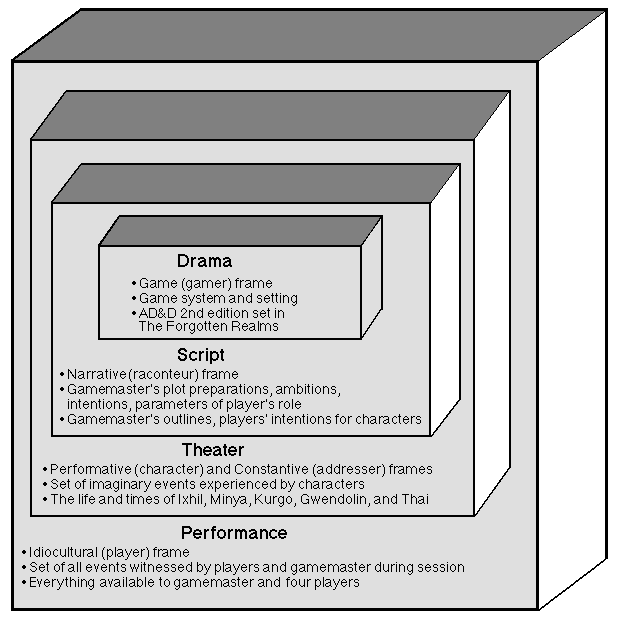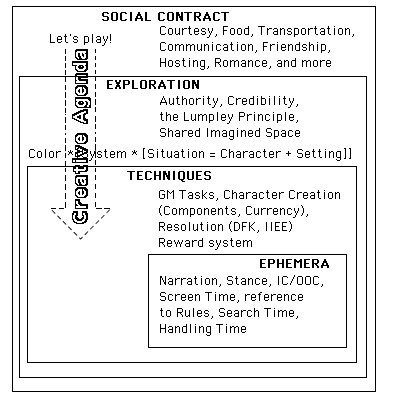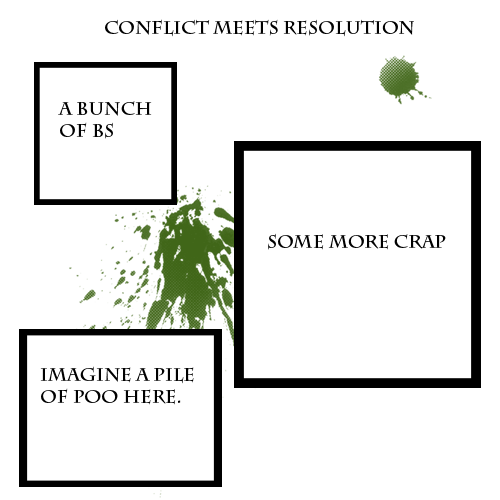Lately, there has been a bunch of GNS / "Big Model" talk on the Knife Fight forum of late. In addition, the_tall_man has posted a series of posts called "The Big Muddle" as a variant of these. The most recent version of the explanation is the RPGnet Revision. (For historical development of this, he first posted a series of LJ posts in five parts (1 , 2 , 3 , 4 , and 5). He then had discussion threads about these on Knife Fight as on Knife Fight (registration required) and on theRPGsite.
I'm drawn to do a compare-and-contrast of some different models of role-playing, particularly in how they create a hierarchical diagram of play. I'll try out several views, ordered chronologically by when they were created. For this, I'm picking out Daniel Mackay, Ron Edwards, Eetu Mäkelä et al, and Levi Kornelsen.
Mackay's Spheres of Performance
In his book The Fantasy Role-Playing Game: A New Performing Art (2001), Daniel Mackay makes a contrasting model of the hierarchy of role-playing based on the theater studies work of Richard Schechner. He is analyzing role-playing as performance, although a very different one from traditional theater. His hierarchy diagram (from page 60 of the book) is:

This is based on increasing levels of specificity in terms of how it is perceived by the players. The "Drama" frame is the nitty-gritty of how the game went, corresponding to a particular performance. The "Script" frame is the context for this, i.e. how the given session was prepared for, but as we all know a game can go in wildly different ways from how it was prepared. The "Theater" frame is the concept of the shared fiction, which the could be adapted in different ways to the game. The "Performance" frame is the widest frame that includes the wider social context outside of the fiction.
Edward's Big Model
Ron Edward's "Big Model" diagram was from about the last stable revision to his GNS discussion, from late 2003. (His "Glossary" article with the specific diagram below was from early 2004.) His approach was in terms of RPG system design.

In some ways it is quite similar to Mackay, though arrived independently. He too puts the elements of fiction (the "Shared Imagined Space") at the second-to-broadest box, and the narrower boxes are more specifics about how that fiction is implemented by the players ("Techniques" and "Ephemera").
One difference that stands out is the emphasis on mechanics design. For example, Edwards puts "IC/OOC" (In-Character/Out-of-Character) in the narrowest box as "Ephemera", whereas Mackay puts "Performative and Constantive" in the second-to-broadest box. On the other hand, Mackay only mentions the mechanical rules in the narrowest box -- whereas Edwards puts "System" in his second-to-broadest box. Mackay has an avowed focus on performance, whereas Edwards is focused on system design. It seems that elements perceived as more important are put in a broader box.
The Process Model
The Process Model of Role-Playing is a paper by Eetu Mäkelä, Sampo Koistinen, Mikko Siukola and Sanni Turunen written for the Knutepunkt 2005 book, "Dissecting larp". It was clearly influenced by Edwards' Big Model, but it is expressed as a flowchart rather than a hierarchy. The diagram is:

Note that there is a slight hierarchy. The "Shared Imagined Space" (SIS) is inside of the "Shared Space of Imagining" (SSI). It shows that "Circumstances", "Roleplaying Processes", and "Methods" overlap with the SIS, whereas Social Processes and Results are apart from it. However, there is no other overlap.
Compared to Edwards' view where techniques are in small boxes within Exploration (including the SIS), this picture puts more emphasis on processes compared to the SIS. Obviously from the title, this was intentional.
Levi Kornelsen's Big Muddle
The latest is Levi Kornelsen's take on Edwards' "Big Model", that he has posted titled as the "Big Muddle", most recently as an RPGnet thread. There are a series of prior diagrams showing people standing in the outside, creating the "Form of Play" through agreement, then stepping inside the form and creating the Fiction through agreement. The final diagram with labels, though, is:

Though this purports to be a version of Edwards' Big Model, it is quite distinct in many ways from Edwards' diagram. Kornelsen identifies the "Form of Play" as including Authority and Credibility, terms from Edwards' model. However, he puts the Fiction (aka Shared Imagined Space) in the smallest box at the center -- while Edwards puts it on the same level as Authority and Credibility.
This is a different conception of fiction, I think. It pictures the fiction as more of a product of play, rather than an active part of the play environment. For both Mackay and Edwards, techniques of role-playing are inside the fiction box. For Kornelsen, they are outside. In the build-up, he pictures the participants creating the Form of Play and then stepping inside it. They also create the fiction, but remain outside of it. It is illustrated as a pile of papers, whereas the Form of Play is a green field that participants stand on.
My Analysis
I don't think any of these diagrams are entirely right or wrong. However, they project the things which they want to emphasize as positions in the diagram. All of them have the full social context as the broadest box -- i.e. including any out-of-game material as well as in-game. However, where rules and fiction and techniques fit in the diagram is purely a matter of emphasis.
For example, in Levi's diagram fiction is the smallest box in the center. However, there are cases of multiple ongoing campaigns set in the same fictional game-world -- where the participants regard the whole as one fiction contributed to by different people, with possibly different forms of play. Similarly, a campaign might switch from using one system to another. Conversely, though, a group might have a regular campaign where they switch settings -- like a weekly GURPS game that changes settings.
As far as giving a structure to play, the definiteness of the diagrams is useful. However, as far as describing how play actually happens, any diagram with more than two levels fails to represent the fluidity of play in work. For example, in Levi's diagrams, the participants get together and specify the form of play first, then create the fiction. However, often players will get together and decide on much of the fiction before they have specified crucial parts of the forms of play. i.e.
"Let's play a Star Wars game!"
"Cool. I've always wanted to play a Wookie Jedi."
"What period should it be set in?"
"Maybe just before the original, that is, A New Hope."
"That sounds good. Should we use the West End D6 system, or the Wizards D20 system?"
"What about using Spirit of the Century or Wushu?"
"Well, each of them handles different things better. Let's figure out more before we decide."
The point being, the group can go back and forth between deciding on entries to the rules and entries to the fiction. They can decide some things, and then go back and change some things previously decided in either. Most often, this is handled outside of the game. However, some games include world-building as part of play, such as Aria: Canticle of the Monomyth or Primetime Adventures.
So I would take all of these diagrams as ways of structuring the a game, but not the only way.




